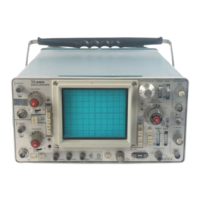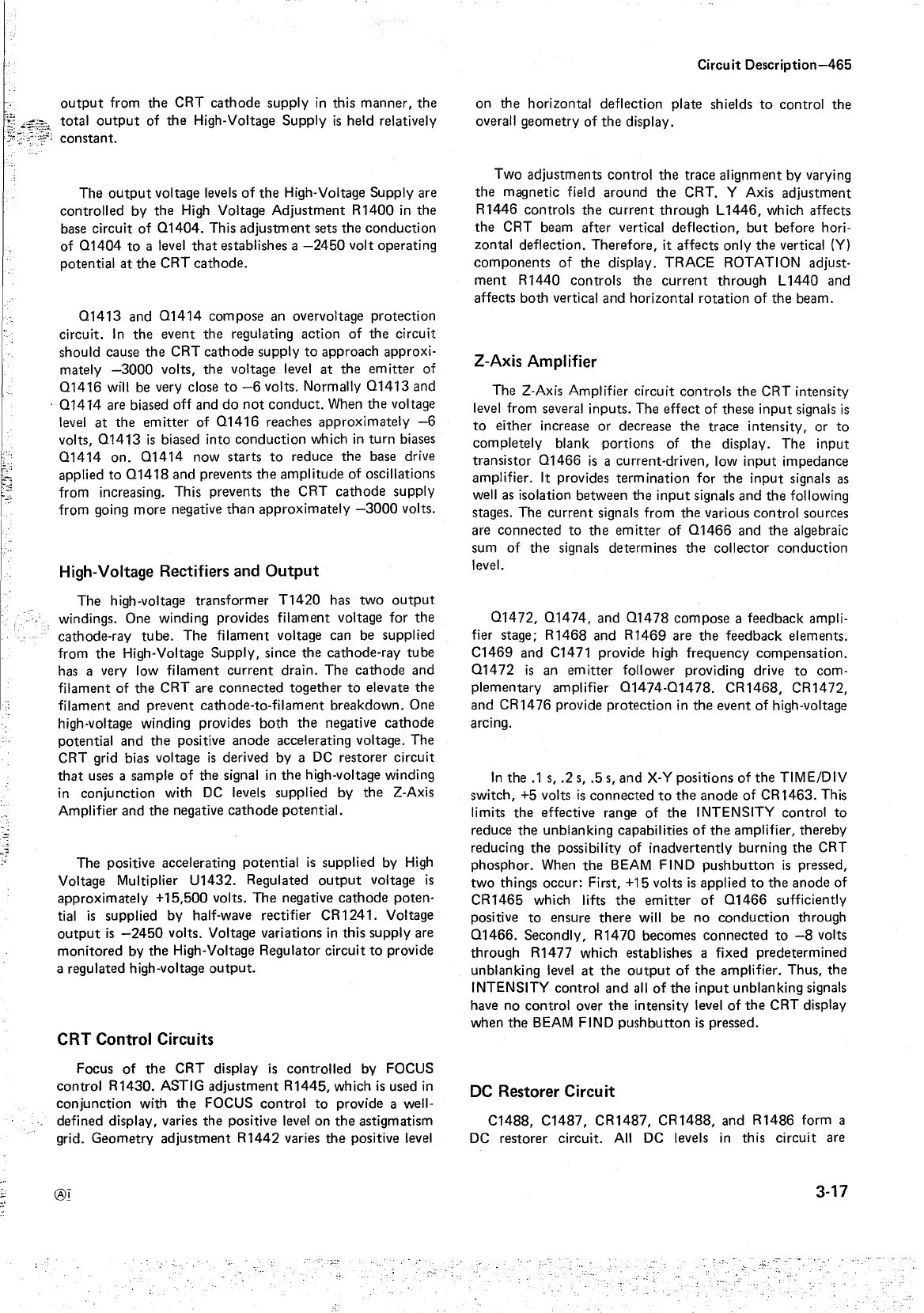_.;...:
output
from
the
CRT cathode supply
in
this manner,
the
total
output
of
the
High-Voltage Supply
is
held relatively
constant.
The
output
voltage levels
of
the
High-Voltage Supply are
controlled by
the
High
Voltage Adjustment R1400
in
the
base circuit
of
01404.
This
adjustment
sets
the
conduction
of
01404
to
a level
that
establishes a
-2450
volt operating
potential
at
the
CRT cathode.
01413
and
01414
compose an overvoltage protection
circuit.
In
the
event
the
regulating action of
the
circuit
should cause
the
CRT
cathode
supply
to
approach approxi-
mately
-3000
volts,
the
voltage level
at
the
emitter of
01416
will
be
very close
to
-6
volts. Normally
01413
and
·
01414
are biased off and
do
not
conduct.
When
the
voltage
level
at
the
emitter of
01416
reaches approximately
-6
volts,
01413
is
biased into conduction which
in
turn
biases
01414
on.
01414
now starts
to
reduce
the
base drive
applied
to
01418
and prevents
the
amplitude of oscillations
from increasing. This prevents
the
CRT cathode supply
from going more negative
than
approximately
-3000
volts.
High-Voltage Rectifiers and
Output
The high-voltage transformer
T1420
has
two
output
windings. One winding provides filament voltage for
the
cathode-ray tube. The filament voltage can be supplied
from
the
High-Voltage Supply, since
the
cathode-ray
tube
has a very low filament
current
drain. The cathode and
filament of
the
CRT are connected together
to
elevate
the
filament and prevent cathode-to-filament breakdown. One
high-voltage winding provides both
the
negative cathode
potential and
the
positive anode accelerating voltage. The
CRT grid bias voltage
is
derived by a
DC
restorer circuit
that
uses a sample
of
the signal
in
the
high-voltage winding
in conjunction with
DC
levels supplied by
the
Z-Axis
Amplifier and
the
negative
cathode
potential.
The positive accelerating potential
is
supplied by
High
Voltage Multiplier U1432. Regulated
output
voltage
is
approximately +15,500 volts. The negative cathode poten-
tial
is
supplied by half-wave rectifier
CR
1241. Voltage
output
is
-2450
volts. Voltage variations
in
this supply are
monitored by
the
High-Voltage Regulator circuit
to
provide
a regulated high-voltage
output.
CRT
Control Circuits
Focus
of
the
CRT display
is
controlled by FOCUS
control R1430. ASTIG adjustment R1445, which
is
used
in
conjunction with
the
FOCUS control
to
provide a well-
defined display, varies the positive level on
the
astigmatism
grid. Geometry adjustment R
1442
varies
the
positive
level
@t
Circuit Description-465
on the horizontal deflection plate shields
to
control
the
overall geometry of
the
display.
Two adjustments control
the
trace alignment by varying
the
magnetic field around
the
CRT. Y Axis adjustment
R1446 controls
the
current through L 1446, which affects
the
CRT beam after vertical deflection,
but
before hori-
zontal deflection. Therefore, it affects only
the
vertical
(Y)
components
of
the
display. TRACE ROTATION adjust-
ment
R1440 controls the
current
through L1440 and
affects both vertical and horizontal rotation
of
the
beam.
Z-Axis Amplifier
The Z-Axis Amplifier circuit controls
the
CRT intensity
level from several inputs. The effect of these
input
signals
is
to
either increase
or
decrease
the
trace intensity, or
to
completely blank portions of
the
display. The input
transistor
01466
is
a current-driven, low input impedance
amplifier.
It
provides termination for
the
input
signals
as
well
as
isolation between the
input
signals and
the
following
stages. The
current
signals from
the
various control sources
are connected
to
the
emitter
of
01466
and
the
algebraic
sum
of
the
signals determines
the
collector conduction
level.
01472,
01474,
and
01478
compose a feedback ampli-
fier stage; R1468 and R1469 are
the
feedback elements.
C1469 and C1471 provide high frequency compensation.
01472
is
an emitter follower providing drive
to
com-
plementary amplifier
01474-01478.
CR1468, CR1472,
and CR1476 provide protection
in
the
event
of
high-voltage
arcing.
In
the
.1
s, .2 s, .5 s, and
X-Y
positions
of
the
Tl ME/DIV
switch, +5 volts
is
connected
to
the
anode
of
CR1463. This
limits
the
effective range
of
the
INTENSITY control to
reduce
the
unblanking capabilities
of
the
amplifier, thereby
reducing
the
possibility
of
inadvertently burning
the
CRT
phosphor. When
the
BEAM
FIND
pushbutton
is
pressed,
two
things occur: First, +15 volts
is
applied
to
the
anode of
CR1465 which lifts
the
emitter
of
01466
sufficiently
positive
to
ensure
there
will be no conduction through
01466.
Secondly, R1470 becomes
connected
to
-8
volts
through R1477 which establishes a fixed predetermined
unblanking level
at
the
output
of
the
amplifier. Thus,
the
INTENSITY control and all
of
the
input
unblanking signals
have no control over
the
intensity level
of
the
CRT display
when
the
BEAM
FIND
pushbutton
is
pressed.
DC Restorer Circuit
C1488, C1487, CR1487, CR1488, and R1486 form a
DC
restorer circuit.
All
DC
levels
in
this circuit are
3-17

